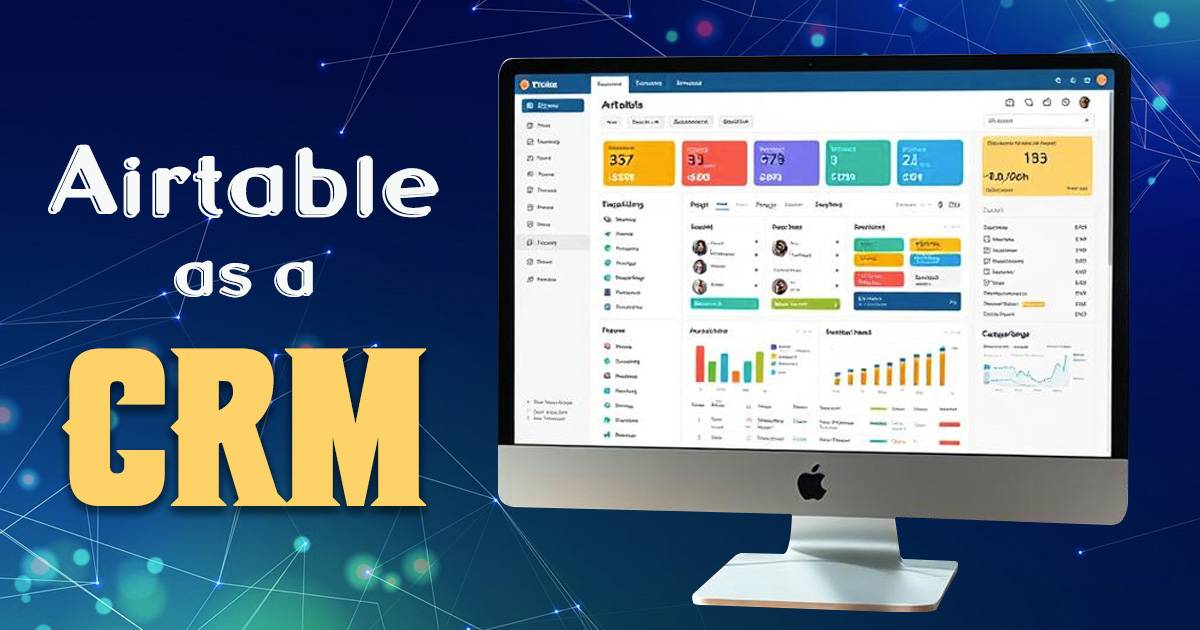Using Airtable for CRM: The Basics

When it comes to business tools, Airtable stands out for its versatility and ease of use. While not marketed solely as a CRM, its features make it capable of handling customer relationship management effectively. Airtable allows businesses to organize, track, and optimize customer data, blending simplicity with powerful database functionalities. For those searching for a flexible alternative to traditional CRMs, Airtable is worth exploring.
What is Airtable?
Airtable is a cloud-based tool that combines the familiarity of spreadsheets with the advanced functionality of a relational database. Imagine Excel on steroids—it’s simple to use, visually engaging, and designed for modern collaboration. Airtable allows users to create “bases,” which act as customizable databases for organizing information. These bases can be tailored to track everything from inventory and project deadlines to marketing campaigns and, yes, customer relationships.
What sets Airtable apart is its adaptability. It integrates seamlessly with tools like Slack, Zapier, and Google Workspace, ensuring your workflows stay connected. Whether you’re managing a creative team, tracking sales leads, or keeping tabs on project milestones, Airtable adapts to meet your specific needs.
Can It Be Used as a CRM?
Yes, Airtable is a fantastic option for businesses that need a CRM solution without the overhead of complex systems. Unlike traditional CRMs, which are designed with pre-built workflows, Airtable gives you the freedom to create your own. You decide how to structure your customer data, define relationships, and set automation.
For example, a small business could use Airtable to track customer interactions, log follow-ups, and manage sales pipelines. A nonprofit might organize donor information and event planning in one base. Since Airtable supports customization, it works well for industries with unique customer management needs.
While it may lack some advanced features, like AI-driven sales forecasts, Airtable excels in simplicity, scalability, and adaptability, making it an excellent choice for startups and small to mid-sized businesses.
How to Use Airtable as a CRM
Airtable provides a strong foundation for building a CRM system that aligns with your business processes. Follow these steps to get started:
Sign-in to Airtable
Getting started with Airtable is easy. Sign up using your email or Google account and log in to access the platform’s dashboard. The free plan is a great way to explore its features, while the paid plans unlock additional perks like advanced automation and larger storage. Once logged in, create a new base and start designing your CRM.
Use the Sales CRM Template
To save time, start with Airtable’s Sales CRM template. This ready-made base includes pre-defined fields for customer names, contact details, deal stages, and more. Templates like these provide a structure that can be easily modified to suit your needs. If your business is new to Airtable, templates act as a great starting point, minimizing the learning curve.
Import Data
If you already have customer data in spreadsheets or other CRMs, Airtable makes it easy to bring that information into your base. Simply upload a CSV or Excel file, and Airtable will guide you through mapping your columns to corresponding fields. This process not only saves time but also ensures that all your customer data is consolidated in one place.
Edit Fields
Customizing fields is where Airtable shines. Add specific fields that matter to your business, like lead source, customer preferences, or follow-up dates. You can choose different field types—checkboxes, dropdown menus, date pickers, or attachments—to make the data more interactive and easier to manage. Tailoring these fields ensures that your CRM works the way you do, rather than forcing you to adapt to a rigid system.
Manage Relationships
One of Airtable’s most powerful features is its ability to handle relational data. For example, you can link a “Contacts” table with a “Deals” table, creating a connection between customers and their transactions. This relational setup helps keep all information organized and easily accessible, eliminating the need to jump between systems. By centralizing everything, you can quickly get a 360-degree view of customer interactions.
Is Airtable Effective for Managing Your Customers?
Absolutely, Airtable offers a practical solution for managing customers effectively. Its intuitive interface and powerful customization tools make it ideal for businesses looking for flexibility. Teams can streamline operations, track customer journeys, and improve overall efficiency without dealing with the complexities of traditional CRMs.
The ability to integrate Airtable with other tools is a game-changer. For example, syncing Airtable with Slack can improve communication across teams, while integrations with email marketing tools like Mailchimp make it easier to maintain engagement with customers. These features make Airtable not just a CRM but a versatile business tool.
However, Airtable does have its limitations. It lacks advanced analytics and reporting features, which might be a dealbreaker for larger enterprises with complex needs. Still, for small and medium-sized businesses, it offers a perfect balance of simplicity and capability.
Why Airtable Could Be Your Next CRM
If you’re looking for a CRM solution that’s adaptable, easy to use, and budget-friendly, Airtable checks all the boxes. It empowers businesses to design systems that align perfectly with their workflows, providing a level of customization that traditional CRMs often lack.
While Airtable may not replace high-end CRMs for large corporations, its features are more than enough for small to mid-sized teams looking to streamline customer management. With Airtable, you’re not just adopting a CRM—you’re gaining a tool that grows with your business, simplifies processes, and makes data management seamless. Give Airtable a try, and discover how it can transform the way you handle customer relationships.
